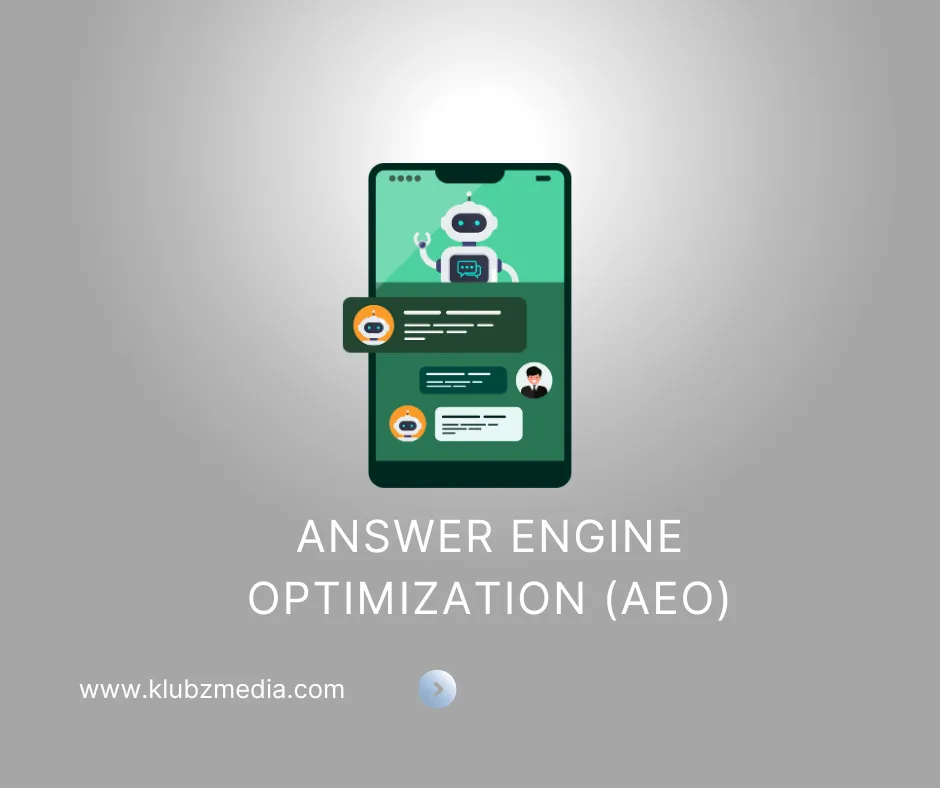Have you observed how search engines now prioritize AI-generated answers? They bring the most relevant information to you instantly. So you can easily scroll through to find reliable content. This shift is part of Answer Engine Optimization (AEO), where AI delivers the most relevant information for your search queries.
Let’s put it definitively,
Answer engine optimization (AEO) is the AI-enhanced version of SEO, which optimizes content for search engines by leveraging AI to provide direct answers to user queries.
The Shift in Search Behavior
The Evolution of Search: From Keywords to Conversational Queries
The search landscape has dramatically transformed over the past decade:
- Early 2000s: Keyword-focused search
- The mid-2010s: Long-tail keyword and intent-based search
- The 2020s: Conversational AI and Direct Answer Optimization
Search engines have changed the way they deliver information, focusing on quick, direct answers. Because of this, my search habits too are different now. I used to type a query into Google and scroll through the first page of results, trusting those as the most reliable. But these days, I rarely do that.
Instead, I go straight to answer engines like ChatGPT, Claude, or Gemini for an instant response. Even when I use Google, it often suggests answers from these tools, making the process faster and more convenient. It’s all about getting the information I need in the quickest way possible. I am sure most of you would relate to it.
According to GWI, People now scan the search engine’s answer box first. This reduces browsing time and increases user satisfaction due to quicker access to relevant information.
So, your traditional content strategy will no longer function if you plan to attract an audience/users from search engines.
The Aim of Answer Engines
Why do you think Google adopted answer engines? The reason is simple—they align with the value Google aims to provide for its users. To optimize your content for answer engines, you need to understand their goals.
1. Provide authentic information in the shortest time
Answer engines are designed to provide quick, accurate responses. They aim to deliver the most authentic information in as little time as possible. For example, when users ask “What’s the capital of France?”, the engine will provide “Paris” directly at the top without any delay.
2. Reduce user journey to find relevant information
Answer engines strive to shorten the path between a query and its answer. Users don’t want to scroll through pages to find what they need. They want answers instantly. To meet this need, make your content easy to navigate. For instance, breaking down complex topics into simple, digestible chunks helps users and search engines find relevant information quickly.
3. Present information short and precisely
The goal is to present content that’s clear and to the point. Short, concise answers are key. For example, when asked “How long to boil an egg?”, a direct answer of “Boil for 7-10 minutes” is far more effective than a lengthy explanation. Organize your content with headers, bullet points, and short paragraphs to enhance clarity and make it easier for engines to extract relevant details.
Top 10 Strategies for Implementing AEO in Content Strategy
Focusing on answer engine optimization is necessary if you aim to succeed in SEO and content marketing by 2025. Check out these 10 strategies.
- Focus on user intent when creating content
- Provide instant gratification with quick, relevant answers
- Target content for featured snippets
- Produce well-structured content for better readability
- Use long-tail keywords to target specific search queries
- Produce helpful content that solves problems
- Optimize content for voice search
- Establish answer authority through reliable sources
- Recognize the importance of FAQs in content
- Adopt a user-focused tone in writing

1. Focus on user intent
To create the most relevant answers, you must start by understanding user intent. This is key to SEO, especially when it comes to keyword research based on user search habits.
However, it’s no longer enough to simply rely on tools and sorted keywords. You need to go deeper—identify what users are searching for, determine the best way to address their queries, and deliver the most accurate answer quickly.
This approach forms the foundation of Answer Engine Optimization (AEO). Focus on the specific questions your audience is asking. For instance, if you’re in the travel niche, tackle queries like, “What are the top destinations for 2024?” Structure your content to provide concise and valuable responses.
2. Instant gratification
Answer engines are designed to simplify the search journey for users. Long introductions and bulky paragraphs won’t work for AEO. Every piece of content needs to offer instant value. Begin with a short, direct introduction and expand on the topic as the content flows. Provide quick and accurate answers right at the start.
Studies reveal that 53% of users leave pages that take longer than three seconds to load. Similarly, readers don’t want to scroll endlessly to find what they need. Keep your content concise and to the point.
3. Target for featured snippets
Featured snippets appear at the top of search results and get about 8% of all clicks. However, answer engines have started taking over this spot. This means you should now focus on optimizing your content for featured snippets.
To do this, provide clear, direct answers that match what users are looking for. Structure your content to answer questions quickly. This increases the chances of being featured at the top of search results or appearing in answer engines like ChatGPT and Google’s tools.
4. Produce structured content
If your content involves broad research, it’s important to structure it first. Start by planning a detailed outline and organizing the information so users can learn in a logical sequence. Once the structure is set, begin writing the content.
Organizing your content is key for both users and search engines. Break your text into clear sections with meaningful headers and subheaders. This helps users navigate easily. Additionally, use schema markup to give search engines more context about your content, improving visibility in search results.
5. Leverage long-tail keywords
Short-tail keywords often require covering broad topics to fulfill content needs. But for AEO, every detail matters. Users prefer 100 specific answers to 100 specific questions, not one big paragraph explaining everything.
To achieve this, focus on long-tail keywords and break your content into smaller, precise segments. These conversational phrases align with how users naturally search. For instance, instead of using “best shoes,” target “best running shoes for beginners.” Long-tail keywords drive 70% of all search traffic and help you provide more targeted, valuable answers.
6. Produce helpful content
We keep telling SEO content writers the same thing—the best way to rank your blog is by creating helpful evergreen content. The same rule applies to AEO. Provide answer engines with valuable content they can present to users.
Focus on solving real problems. Answer questions thoroughly and offer actionable advice. For instance, if you’re writing about gardening, don’t just explain how to grow tomatoes—add tips on preventing common pests. This kind of detailed, useful content is what both users and answer engines value most.
7. Optimize for voice search
Voice search is becoming increasingly popular, with 27% of the global online population now using it on mobile devices. This shift in user behavior has transformed how people search for information. Unlike traditional text searches, voice queries are more conversational and natural, reflecting how people speak in daily life. For instance, instead of typing “money-saving tips,” a voice search might ask, “What’s the easiest way to save money?”
Answer engines like ChatGPT and others have embraced this trend by integrating voice search options. These tools allow users to ask questions verbally and receive direct, conversational answers. This makes it even more important to optimize your content for voice-based interactions.
To align with this shift, write content that mimics natural speech. Use full sentences and conversational phrases that match how people talk. Focus on answering questions directly and clearly, as voice searches often begin with “how,” “what,” or “why.”
8. Establish answer authority
To succeed in both traditional search and Answer Engine Optimization (AEO), your content must be seen as trustworthy and credible. This is what establishes your authority in the eyes of users and search engines alike. But how do you achieve this?
Start by backing up your content writing with reliable sources. Cite reputable data, link to credible studies, and include expert insights where possible. For instance, if you’re creating content about healthcare, referencing peer-reviewed studies, government websites, or respected medical journals adds credibility and boosts your authority.
Showcasing your expertise is equally important. Make your credentials clear if you’re an industry expert or collaborate with professionals to enhance the depth of your content. For example, a financial blog written by a certified financial planner or quoting a tax advisor can greatly enhance the perceived authority of your content.
9. Include FAQs
FAQs are a powerful tool for addressing common questions, improving user experience, and enhancing AEO (Answer Engine Optimization). Adding an FAQ section to your blogs, product pages, or service pages ensures users can quickly find the answers they need without digging through lengthy content. In e-commerce, for example, FAQ sections can reduce customer support inquiries by up to 25%, saving time while building trust.
From an AEO perspective, FAQs align perfectly with how answer engines function. Answer engines prioritize content that directly addresses user queries. Moreover, FAQs help target long-tail keywords and question-based searches, which are key in both voice and traditional search.
10. Adopt a user-focused tone
Write in a conversational and relatable tone that speaks directly to your audience. Avoid jargon and make your content easy to understand. For example, instead of saying, “Leverage your core competencies,” say, “Focus on your strengths.” This makes your content more approachable and engaging.
When your content is simple and relatable, it’s easier for answer engines to understand and present it to users.
Challenges and Considerations in Answer Engine Optimization

1. Rapid technological changes in AI search
The AI search landscape is changing fast:
- Technological Volatility: A Gartner report states that 80% of emerging technologies will experience significant changes within 2-3 years of launch.
- AI Search Market Growth: The global AI search market is set to grow from $14.7 billion in 2023 to $42.5 billion by 2028, with a CAGR of 23.7%.
- Adaptation Challenge: A McKinsey survey reveals that 72% of marketing leaders are struggling to keep up with rapidly evolving digital technologies.
Impact on Content Strategy:
- Continuous learning and adaptation are critical
- Higher investments in tech and training
- Need for agile content development processes
2. Increased competition for answer placements
The fight for visibility in answer engines is intensifying:
- Featured Snippet Competition: SEMrush data shows only 19.5% of queries currently display featured snippets.
- Zero-Click Searches: Google reports that 49% of searches now end without a click to external websites.
- Content Saturation: HubSpot research indicates that over 7.5 million blog posts are published daily, making it harder to stand out.
Competitive Landscape Challenges:
- Declining organic search click-through rates
- Higher expectations for content quality and expertise
- Growing need for unique, authoritative content
- Increasing importance of topical authority
3. Constant content updates and maintenance
The shelf life of digital content is shortening:
- Content Freshness: Backlinko’s study shows that republishing old blog posts can boost organic traffic by up to 106%.
- Information Decay: Around 2.5 quintillion bytes of data are created daily, making content obsolescence a constant challenge.
- Update Frequency: HubSpot suggests updating content every 3-6 months to maintain relevance.
Maintenance Challenges:
- Resource-intensive content management
- Ongoing research and fact-checking
- Monitoring industry trends
- Implementing real-time updates
4. Balancing comprehensiveness with concision
Creating content that satisfies both AI algorithms and human readers is difficult:
- Attention Span: Microsoft research shows that human attention spans have decreased to just 8 seconds, shorter than a goldfish’s.
- Ideal Content Length: Medium’s study suggests that the optimal article reading time is about 7 minutes, or 1,600-1,800 words.
- AI Snippet Preferences: Google recommends that answer snippets be between 40-50 words for optimal display.
Content Optimization Challenges:
- Providing concise yet comprehensive answers
- Balancing depth with brevity
- Structuring content for both human and AI consumption
- Creating modular, easily extractable content
5. Technical and algorithmic uncertainties
The opaque nature of AI search adds another layer of complexity:
- Algorithm Opacity: Only 36% of marketers fully understand how AI search algorithms determine content rankings.
- Machine Learning Variability: AI models can yield inconsistent results, with accuracy ranging from 60-85% depending on the domain.
- Ethical Considerations: Concerns over AI bias and the accuracy of information continue to rise.
Technical Challenge Breakdown:
- Unpredictable ranking factors
- Complex schema and markup requirements
- Continuous technical optimization needs
- Balancing human expertise with algorithmic preferences
Practical Implementation Roadmap
90-Day AEO Implementation Plan
Phase 1: Research and Preparation (30 Days)
- Conduct comprehensive query research
- Develop initial content strategy
- Identify key topic clusters
- Create content briefs
Phase 2: Content Creation (30 Days)
- Develop initial content assets
- Implement technical optimizations
- Apply schema markup
- Conduct initial quality assessments
Phase 3: Monitoring and Optimization (30 Days)
- Track performance metrics
- Analyze user engagement
- Refine content strategy
- Implement iterative improvements
End Note
Answer Engine Optimization is about meeting users where they are, with answers that matter. It’s not just about visibility; it’s about being the solution your audience trusts. If your content isn’t optimized for AEO, you’re missing out on the opportunity to stand out where it matters most.
That’s where Klubz Media comes in. We specialize in optimizing your content for answer engines, ensuring it’s not only seen but also valued.


